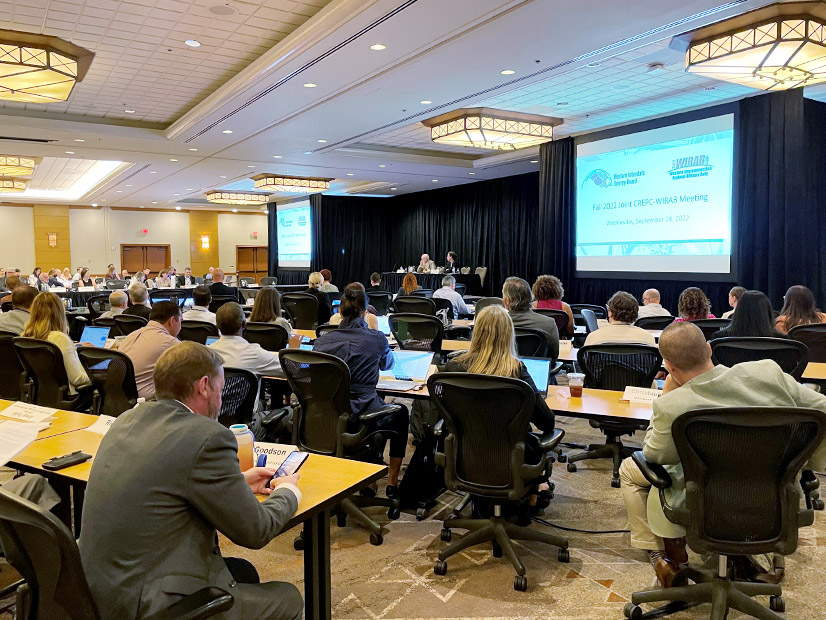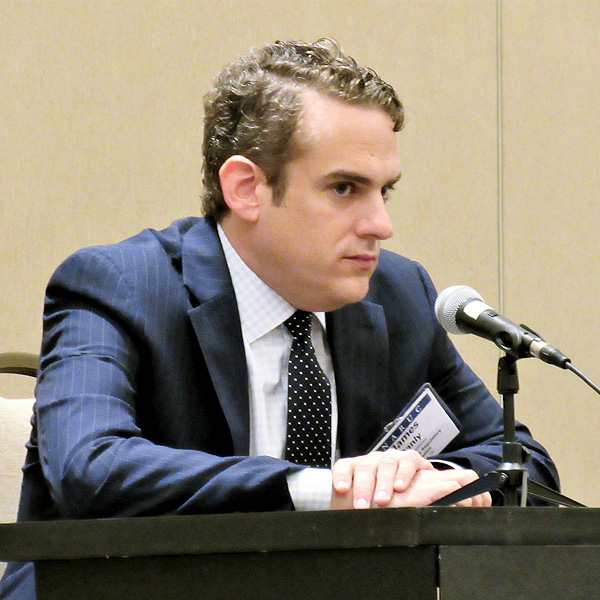TEMPE, Ariz. — FERC Commissioners Mark Christie and James Danly spoke last week about the West’s pursuit of greater regional coordination, with Christie praising the region’s “organic” efforts to form one or more organized markets and Danly warning against RTOs that fail to promote competition and reliability.
The commissioners made their comments at the fall joint meeting of the Committee on Regional Electric Power Cooperation and the Western Interconnection Regional Advisory Body, where CAISO, SPP and the Western Power Pool (WPP) pitched their planned market and reliability programs.
CAISO is planning an extended day-ahead market (EDAM) for its real-time Western Energy Imbalance Market (WEIM). SPP launched its Western Energy Imbalance Service (WEIS) and is developing Markets+, a bundle of services that stops short of a full RTO. And WPP’s Western Resource Adequacy Program (WRAP) has attracted participants from across the Western Interconnection. It expects to begin a preliminary phase of operations soon as it awaits FERC approval.
“You’ve got a lot of options in the West now that are percolating up, and what characterizes every one of these options — the WEIM, the WEIS, the Markets+, the EDAM and [the WRAP] — is that these are all organic, that are coming from you,” Christie said. “FERC didn’t tell you, ‘Here it is. Do it.’ They’re being developed by you … to meet your needs, and I think that’s what’s so exciting. I’m a big believer in organic, evolutionary change [that is] bottom-up … and not being forced down from FERC.”
Christie recommended Western stakeholders look at “another organic development,” the Southeast Energy Exchange Market (SEEM), an automated bilateral 15-minute market set to launch later this year.
 State regulators and stakeholders listen to FERC Commissioner Mark Christie and Oregon PUC Commissioner Letha Tawney. | © RTO Insider LLC
State regulators and stakeholders listen to FERC Commissioner Mark Christie and Oregon PUC Commissioner Letha Tawney. | © RTO Insider LLC
What’s important to recognize, he said, is that the West does not have to choose between no cooperation and an RTO.
“That’s not the binary choice that you face,” Christie said. “There are a lot of points on the continuum, and it’s for you to pick and choose what points makes sense for you.”
Christie, a longtime utility regulator in Virginia before he joined FERC, urged Western regulators to protect the public’s interests when considering their utilities’ plans to join organized markets.
Oregon PUC Commissioner Letha Tawney, who shared the stage with Christie and moderated the discussion, asked how state regulators could balance their roles of making neutral decisions on regulatory matters before them and advocating for the public’s interests when dealing with organizations such as CAISO, SPP and WPP.
Christie, a founding member of the Organization of PJM States Inc. (OPSI), said a “critically important topic” would be whether to form similar advocacy committees of state representatives in the West.
“It is unrealistic to think that states are not going to be cooperating and working with your fellow state regulators,” he said. “I mean, whatever you choose in the West — whether it’s just an energy market, an energy market plus a day-ahead market, [or a] full RTO with all the bells and whistles — whatever you choose you really need an organization like OPSI” empowered to have an advocacy role.
Governance and cost-allocation are among the issues sure to be argued over, he said.
“Cost allocation in a multi-state RTO with radically different [state] policies is an extremely difficult nut to crack,” Christie said. “And you all are sitting out here in the West … [where] every state not named California has a concern about who gets to appoint the board.”
Danly Speaks
In a separate session, Danly warned that joining an RTO could have significant drawbacks, especially if the RTO cannot ensure it has adequate resources or fair competition.
“I often think that people are not quite perfectly aware of the costs and benefits that market participation has,” Danly said.
“There are undeniable benefits that the markets have delivered,” he said. “They have driven costs for power down. There are efficiencies of scale that are so attractive that even those regions that do not want markets have, as in the case of SEEM, tried to capture as many of those benefits as they can. And that may well be the model that’s used going forward, that people creep right up to the line of a full-on RTO but don’t quite cross that threshold.”
 FERC Commissioner James Danly discussed what he said were the downsides of some organized markets. | © RTO Insider LLC
FERC Commissioner James Danly discussed what he said were the downsides of some organized markets. | © RTO Insider LLCEven so, the costs of joining a market can be “multiple,” Danly said.
“My admonition to any state or utility that’s contemplating joining markets in the West … [is that] you to do it with your eyes fully open,” he said.
A frequent CAISO critic, Danly pointed out the ISO’s problems as recently as last month in maintaining resource adequacy during summer heat waves. On Sept. 6 the utility declared a stage 3 energy emergency, instructing utilities to arm for load shed. It narrowly averted rolling blackouts after the California Governor’s Office of Emergency Services sent out a text alert to millions of cell phones telling residents to “conserve energy now” or “power interruptions may occur.”
The message reduced demand by 2,100 MW in 5 minutes, the U.S. Energy Information Administration said Wednesday.
CAISO has declared energy emergencies the past two summers and initiated rolling blackouts in August 2020.
“One of the biggest [drawbacks of organized markets] is what I think are the fairly evident failures of some of the markets to ensure resource adequacy,” Danly said. “And this is something that in the West you’re well aware of because of very recent experience in having had a squeaker with the hot weather in California [and] merely having made it through that with the lights on.”
Markets that incentivize and subsidize certain types of resources, lowering costs, impede the competition that makes a market work, he said.
“If you have a market structure that does not insulate itself correctly [from anti-competitive forces], then what you’re going to find, as we see for example in New England, is that the jurisdictions in which the market operates are acting to undermine the very premise of the market,” he said.
New England, long troubled by tight natural gas supplies in winter, is facing a more limited supply this year because of the war in Ukraine and the century-old Jones Act, which prevents foreign-owned tankers from bringing U.S. liquefied natural gas to domestic ports and forces New England to rely on Russian LNG.
“Markets, especially in the case of capacity markets, are there to ensure that a sufficient quantity of capacity is delivered,” Danly said. “That’s done by a series of auctions in which market incentives are supposed to draw people into delivering the quantity and type of resources necessary to ensure that the system remains stable and has enough electricity.
“And yet, when you have state policies enacted that serve to suppress capacity prices, then you find yourself short,” he said. “And right now, we have a market in the Northeast in which the market has told us in public, on the record, in a FERC tech conference that given the constraints under which it operates … it is not possible to use market mechanisms to ensure resource adequacy. That should be a chilling prospect for anybody who is considering participation in a market.”
If reliability is a problem in New England, where states “have similar and in-parallel public policy goals … I would just suggest that people imagine what it would be like to join a full FERC-jurisdictional RTO [in the West where] you would have a market that has to be the ultimate deliverer of services and guarantor of resource adequacy for states as divergent in their public policy goals as, let’s say, Oregon and Utah.”
